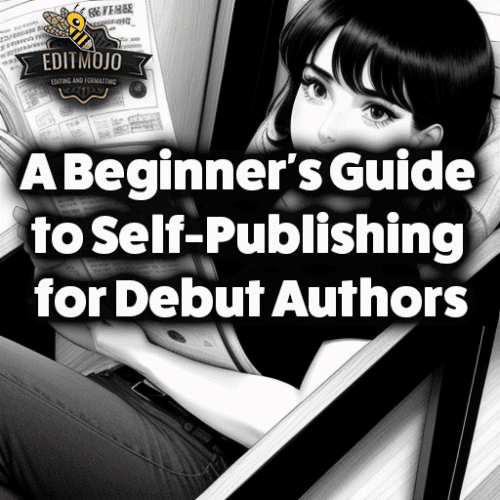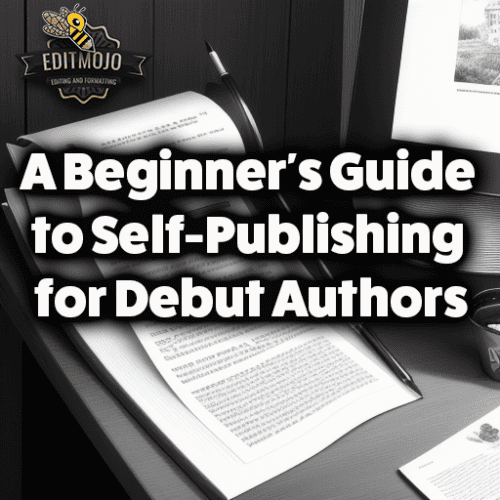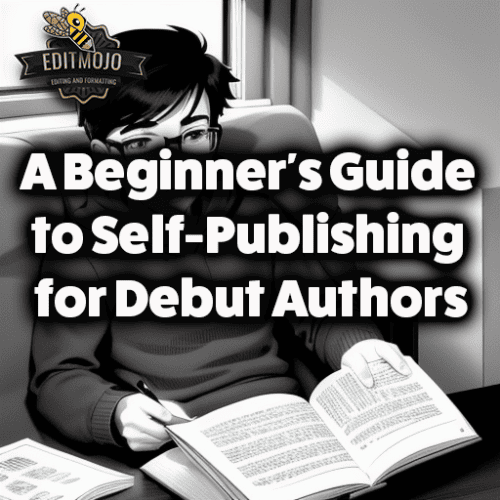A beginner’s guide to self-publishing for debut authors
A beginner’s guide to self-publishing for debut authors. The written word has traveled a long journey, from the papyrus scrolls of ancient Egypt to the hardbound volumes of the 20th century. In the 21st century, it has taken yet another turn with self-publishing – a democratic, revolutionary form that enables any author, seasoned or novice, to publish their work independently. In this comprehensive guide, we’ll explore the promising landscape of self-publishing, providing practical advice to help debut authors navigate their exciting journey ahead.
Key Takeaways Table
| Key Takeaways | |
|---|---|
| Understanding Self-Publishing | Self-publishing offers authors complete control over the creative process, pricing, and distribution of their book. |
| Pre-Publishing Steps | Essential steps include writing, understanding the target audience, professional editing, and designing a catchy book cover. |
| Self-Publishing Platforms | Platforms like Amazon KDP, Smashwords, and Lulu are vital tools for self-publishing. Choose based on your specific needs and objectives. |
| Legal and Financial Aspects | Understand key concepts like ISBN, copyright, royalties, and self-publishing costs. |
| Marketing Strategies | Marketing is a crucial part of the self-publishing journey. Harness social media, gain reviews, collaborate with influencers, and consider paid advertising. |
| Overcoming Challenges | Common challenges include balancing creative and business roles, dealing with criticism, and managing time. |
| Post-Publishing | Use your debut book as a launchpad for future projects, build an author platform, and network with the self-publishing community. |
| Additional Resources | Utilize resources like books, online courses, and various tools for writing, editing, formatting, and marketing. |
A. Brief Overview of Self-Publishing
Self-publishing is a process where an author undertakes the publication of their work without involving a traditional publishing company. This might sound daunting, but in reality, it’s made far simpler by today’s technology and platforms.
B. The Rise and Importance of Self-Publishing in the Digital Age
The advent of digital platforms has fundamentally transformed the publishing landscape, making it accessible to everyone. In fact, self-publishing has become a fast-growing segment in the publishing industry, with increasing numbers of authors choosing this path every year.

C. Why Should Debut Authors Consider Self-Publishing
Imagine being able to control the creative process, pricing, and distribution of your book. Well, that’s the core of self-publishing. It provides a unique opportunity for authors to retain full control over their work, ensuring their vision is fully realized, uncompromised by external influences.
II. Understanding Self-Publishing: Basic Concepts
A. Definition and Core Concepts of Self-Publishing
The essence of self-publishing lies in its name itself: ‘self’ and ‘publishing.’ It involves the author taking on the roles traditionally fulfilled by publishers – writing, editing, designing, publishing, and marketing.
B. Traditional Publishing vs Self-Publishing: Key Differences and Benefits
Comparing traditional publishing to self-publishing is akin to comparing apples to oranges. Traditional publishing involves submitting your manuscript to multiple publishing houses, awaiting acceptance, relinquishing a certain level of creative control, and splitting royalties. Self-publishing, on the other hand, grants you the liberty to bypass these hurdles. The creative control is absolute, and the profits are entirely yours. It’s a bit like choosing between climbing a mountain or creating your own path up it.
C. The Role of Self-Publishing Platforms
Self-publishing platforms are your digital enablers. They provide a space for your book to be published and sold. Think of them as your virtual bookstore and distributor rolled into one.
D. Inspirational Success Stories: Famous Authors who Began with Self-Publishing
Not all successful authors started with big publishing deals. In fact, some of the most famous authors, like E.L. James with Fifty Shades of Grey or Amanda Hocking with her Trylle Trilogy, began their journey through self-publishing. These success stories are not outliers. They are proof of the power and potential of self-publishing.
III. Getting Started: Pre-Publishing Steps
A. Writing Your Book: Essential Tips for Debut Authors
The heart of publishing, traditional or self, is the book itself. Writing is the first, and arguably, the most critical step in your journey. Remember, a well-structured plot, relatable characters, and an engaging narrative style can make your book stand out. It’s also crucial to stay consistent, setting aside dedicated time each day for writing.
B. Understanding and Researching Your Target Audience
Every story has a listener, every book a reader. Identifying your book’s potential audience is like finding your North Star, guiding you through the writing and publishing process. Consider demographics, interests, and reading habits. The more you understand your target audience, the better you can tailor your book to resonate with them.

C. Importance of Professional Editing and Proofreading
A manuscript free of grammatical errors and plot inconsistencies significantly improves reader experience. Consider hiring a professional editor, who can bring an objective perspective to your work and help polish it to its full potential.
D. Designing a Catchy and Relevant Book Cover
They say, “don’t judge a book by its cover.” However, in the publishing world, a catchy cover can make a significant difference. A compelling, professionally designed cover can grab potential readers’ attention and increase your book’s marketability.
IV. Navigating Self-Publishing Platforms
A. An Overview of Popular Self-Publishing Platforms
There are several self-publishing platforms available today, such as Amazon Kindle Direct Publishing (KDP), Smashwords, and Lulu. Each platform has its strengths and weaknesses, and the choice should be made based on your specific needs and objectives.
B-D. Detailed Guide: How to Self-Publish on Different Platforms
Each platform has a slightly different process for publishing. Take the time to understand the ins and outs of your chosen platform. For example, Amazon KDP provides a detailed guide to get you started.
E. Pros and Cons of Each Platform and How to Choose the Right One
Choosing the right platform involves understanding your publishing goals, audience, and the unique features each platform offers. Remember, what works for one author might not work for another. Hence, research is key.
V. Legal and Financial Aspects of Self-Publishing
A. Understanding ISBN and Copyrights
ISBN (International Standard Book Number) is like a social security number for your book. It’s crucial for distribution and sales tracking. Copyright, on the other hand, protects your work from being stolen or misused. Understanding these legal aspects is crucial before you publish your book.
B. Explaining Royalties, Pricing, and Profit Margins in Self-Publishing
In self-publishing, you earn a percentage of each book’s sale, known as royalties. Each platform offers different royalty rates. Pricing your book appropriately can influence your sales and ultimately, your profit margins.
C. The Cost of Self-Publishing: An Honest Breakdown
Self-publishing is not entirely without costs. Expenses may include cover design, editing, formatting, and marketing. However, these costs are often recouped through book sales, especially when compared to the modest royalties offered by traditional publishers.
VI. Marketing Your Self-Published Book
A. Importance of Pre-launch and Post-launch Marketing Strategies
Marketing should be an integral part of your self-publishing journey, and it begins even before your book is published. Pre-launch strategies like building an online presence, getting reviews, and offering pre-orders can create anticipation. Post-launch strategies, on the other hand, focus on keeping the momentum going with ongoing promotions.

B. Harnessing the Power of Social Media to Promote Your Book
In our digital age, social media is a powerful marketing tool. You can engage directly with your audience, create buzz around your book, and even run cost-effective ads. For instance, an Instagram story unveiling your book cover could generate excitement among your followers.
C. Effective Strategies for Gaining Reviews and Building Reader Trust
Positive reviews can significantly boost your book’s credibility. Encourage your readers to leave reviews. Consider offering free copies to reviewers or conducting giveaways. A glowing review can be a persuasive factor for potential readers.
D. Partnering with Bloggers, Podcasters, and Influencers for Promotion
Working with influencers in your genre can extend your reach. Their endorsement can introduce your book to a larger audience and create additional buzz.
E. Paid Advertising: An Introduction to Amazon Ads and Facebook Ads
Paid advertising can significantly increase your book’s visibility. Platforms like Amazon and Facebook offer targeted advertising, ensuring your ads reach the right audience.
VII. Overcoming Challenges in Self-Publishing
A. Common Hurdles for Debut Self-Published Authors and How to Overcome Them
Like any venture, self-publishing comes with its set of challenges. But remember, every hurdle is a learning opportunity. Being prepared and flexible can help you navigate these challenges successfully.
B. Balancing Creative Writing and Business Management
Self-publishing requires a balance between your creative and entrepreneurial roles. It might be challenging, but it’s also empowering. Remember, you are now in charge of your book’s destiny.
C. Dealing with Criticism and Negative Reviews
Every author faces criticism, and it’s essential to handle it constructively. View it as an opportunity for growth and improvement. After all, “The road to success and the road to failure are almost exactly the same.” – Colin R. Davis.
VIII. Post-Publishing: Creating a Sustainable Writing Career
A. Using Your Debut Book as a Launchpad for Future Projects
Your debut book is just the beginning. With each book, you’ll learn, grow, and refine your craft and process.
B. Building an Author Platform: Websites, Blogs, and Newsletters
An author platform helps you maintain a connection with your readers, keep them updated about your upcoming work, and provide valuable content. This relationship with your readers can be the key to a successful writing career.
C. Connecting with Readers and Other Authors: Networking in the Self-Publishing Community
Engage with other authors and readers through forums, writer’s groups, and social media. Sharing experiences and learning from others can be incredibly enriching.
IX. Additional Resources and Tools for Self-Publishing Authors
A. Top Recommended Books and Online Courses on Self-Publishing
Consider exploring resources such as Joanna Penn’s books and Mark Dawson’s Self Publishing Formula. They offer invaluable insights into the self-publishing process.
VI. Marketing Your Self-Published Book
A. Importance of Pre-launch and Post-launch Marketing Strategies
Marketing should be an integral part of your self-publishing journey, and it begins even before your book is published. Pre-launch strategies like building an online presence, getting reviews, and offering pre-orders can create anticipation. Post-launch strategies, on the other hand, focus on keeping the momentum going with ongoing promotions.
B. Harnessing the Power of Social Media to Promote Your Book
In our digital age, social media is a powerful marketing tool. You can engage directly with your audience, create buzz around your book, and even run cost-effective ads. For instance, an Instagram story unveiling your book cover could generate excitement among your followers.
C. Effective Strategies for Gaining Reviews and Building Reader Trust
Positive reviews can significantly boost your book’s credibility. Encourage your readers to leave reviews. Consider offering free copies to reviewers or conducting giveaways. A glowing review can be a persuasive factor for potential readers.
D. Partnering with Bloggers, Podcasters, and Influencers for Promotion
Working with influencers in your genre can extend your reach. Their endorsement can introduce your book to a larger audience and create additional buzz.
E. Paid Advertising: An Introduction to Amazon Ads and Facebook Ads
Paid advertising can significantly increase your book’s visibility. Platforms like Amazon and Facebook offer targeted advertising, ensuring your ads reach the right audience.
VII. Overcoming Challenges in Self-Publishing
A. Common Hurdles for Debut Self-Published Authors and How to Overcome Them
Like any venture, self-publishing comes with its set of challenges. But remember, every hurdle is a learning opportunity. Being prepared and flexible can help you navigate these challenges successfully.
B. Balancing Creative Writing and Business Management
Self-publishing requires a balance between your creative and entrepreneurial roles. It might be challenging, but it’s also empowering. Remember, you are now in charge of your book’s destiny.
C. Dealing with Criticism and Negative Reviews
Every author faces criticism, and it’s essential to handle it constructively. View it as an opportunity for growth and improvement. After all, “The road to success and the road to failure are almost exactly the same.” – Colin R. Davis.
VIII. Post-Publishing: Creating a Sustainable Writing Career
A. Using Your Debut Book as a Launchpad for Future Projects
Your debut book is just the beginning. With each book, you’ll learn, grow, and refine your craft and process.
B. Building an Author Platform: Websites, Blogs, and Newsletters
An author platform helps you maintain a connection with your readers, keep them updated about your upcoming work, and provide valuable content. This relationship with your readers can be the key to a successful writing career.
C. Connecting with Readers and Other Authors: Networking in the Self-Publishing Community
Engage with other authors and readers through forums, writer’s groups, and social media. Sharing experiences and learning from others can be incredibly enriching.
IX. Additional Resources and Tools for Self-Publishing Authors
A. Top Recommended Books and Online Courses on Self-Publishing
Consider exploring resources such as Joanna Penn’s books and Mark Dawson’s Self Publishing Formula. They offer invaluable insights into the self-publishing process.
B. Essential Tools for Writing, Editing, Formatting, and Marketing
There’s a multitude of tools available to assist you in your self-publishing journey. From writing tools like Scrivener, editing tools like Grammarly, to marketing tools like MailChimp, each can simplify a facet of the process.
C. How to Stay Up-to-date with Self-Publishing Trends and Industry Changes
Stay informed about the latest trends and changes in the self-publishing industry. Blogs like The Book Designer and The Creative Penn provide regular updates and insights.
X. Conclusion (A beginner’s guide to self-publishing for debut authors)
Self-publishing is an exciting journey, one filled with possibilities and opportunities. It’s a path that allows you to express your creativity, share your ideas, and connect with readers worldwide. It may seem challenging at first, but with patience, persistence, and a passion for your craft, it can lead to an incredibly rewarding experience.
Remember, every journey begins with a single step. So, go ahead and take yours. Start writing, start learning, and embrace the adventure that is self-publishing.
Feel free to share your thoughts, ask questions, or share your own self-publishing experiences. Your story might just inspire another aspiring author to start their journey.
Top Five Questions and Answers Table
| Questions | Answers |
|---|---|
| What is self-publishing? | Self-publishing is a process where authors independently publish their work without involving a traditional publishing company. |
| How does self-publishing compare to traditional publishing? | In self-publishing, authors retain full control over their work and the entirety of the profits. In traditional publishing, the process is often lengthy, and authors share profits with the publisher. |
| What are some popular self-publishing platforms? | Popular self-publishing platforms include Amazon Kindle Direct Publishing (KDP), Smashwords, and Lulu. |
| How can I market my self-published book? | You can harness social media platforms, gain reviews, collaborate with influencers, and consider paid advertising to market your book. |
| What are some challenges I might face as a self-published author? | Some challenges include balancing creative writing and business management, dealing with criticism, and navigating the legal and financial aspects of publishing. |
